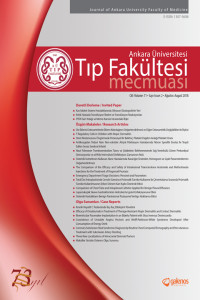Öz
Proje Numarası
-
Kaynakça
- 1. Beard CM, Sheps SG, Kurland LT. Occurrence of pheochromocytoma in Rochester, Minnesota, 1950 through 1979. Mayo ClinProc. 1983;58:802- 804.
- 2. Tischler AS, de Krijger RR, Gill A, et al. Pheochromocytoma. In: WHO Classification of Tumours of Endocrine Organs, 4th, Lloyd RV, Osamura RY, Kloppel G, Rosai J (Eds), IARC, Lyon 2017. p.183.
- 3. Ayala-Ramirez M, Feng L, Johnson MM, et al. Clinical risk factors for malignancy and overall survival in patients with pheochromocytomas and sympathetic paragangliomas: primary tumor size and primary tumor location as prognostic indicators. J Clin Endocrinol Metab. 2011;96:717.
- 4. Waguespack S.G., Rich T., Grubbs E. A current review of the etiology, diagnosis, and treatment of pediatric pheochromocytoma and paraganglioma. J Clin Endocrinol Metab. 2010;95:2023-2037.
- 5. Strajina V, Dy BM, Farley DR, et al. Surgical Treatment of Malignant Pheochromocytoma and Paraganglioma: Retrospective Case Series. Ann Surg Oncol. 2017;24:1546.
- 6. Fishbein L, Bonner L, TorigianDA, et al. External beam radiationtherapy (EBRT) fo patients with malignant pheochromocytoma and non-head and –neck paraganglioma: combination with 131I-MIBG. Horm Metab Res. 2012;44:405-410.
- 7. McBride JF, Atwell TD, Charboneau WJ, et al. Minimally invasive treatment of metastatic pheochromocytoma and paraganglioma: efficacy and safety of radio frequency ablation and cryoablation therapy. J Vasc Interv Radiol. 2011;22:1263.
- 8. Safford SD, Coleman RE, Gockerman JP, et al. Iodine -131 metaiodobenzylguanidine is an effective treatment for malignant pheochromocytoma and paraganglioma. Surgery. 2003;134:956.
- 9. Huang H, Abraham J, Hung E, et al. Treatment of malignant pheochromocytoma/paraganglioma with cyclophosphamide, vincristine, anddacarbazine: recommendationfrom a 22-year follow-up of 18 patients. Cancer. 2008;113:2020.
- 10. Schlumberger M, Gicquel C, Lumbroso J et al. Malignant pheochromocytoma: Clinical, biological, histologic and therapeutic data in a series of 20 patients with distant metastases. J Endocrinol Invest. 1992;15:631-642.
- 11. 11.Joshua AM, Ezzat S, Asa SL, et al. Rationale and evidence for sunitinib in the treatment of malignant paraganglioma/pheochromocytoma. J Clin Endocrinol Metab. 2009;94:5.
Öz
Pheochromocytomas are catecholamine-secreting neuroendocrine tumors that arise from chromaffin cells of the adrenal medulla. At least 10 percent of pheochromocytomas are malignant. A diagnosis of malignant pheochromocytoma can only be made by identifying tumor deposits in tissues that do not normally contain chromaffin cells. The clinical course of malignat pheochromocytoma is highly variable, with reported five-year survival rates that range widely from 12 to 84 percent. We report a rare case of a 38-year-old female who have malignant pheochromocytoma. We review the classic and current literature regarding management of this uncommon tumor
Anahtar Kelimeler
Malignant Pheochromocytoma Treatment Adrenal Neuoroendocrine
Etik Beyan
Hasta onayı alınmamıştır
Destekleyen Kurum
-
Proje Numarası
-
Teşekkür
-
Kaynakça
- 1. Beard CM, Sheps SG, Kurland LT. Occurrence of pheochromocytoma in Rochester, Minnesota, 1950 through 1979. Mayo ClinProc. 1983;58:802- 804.
- 2. Tischler AS, de Krijger RR, Gill A, et al. Pheochromocytoma. In: WHO Classification of Tumours of Endocrine Organs, 4th, Lloyd RV, Osamura RY, Kloppel G, Rosai J (Eds), IARC, Lyon 2017. p.183.
- 3. Ayala-Ramirez M, Feng L, Johnson MM, et al. Clinical risk factors for malignancy and overall survival in patients with pheochromocytomas and sympathetic paragangliomas: primary tumor size and primary tumor location as prognostic indicators. J Clin Endocrinol Metab. 2011;96:717.
- 4. Waguespack S.G., Rich T., Grubbs E. A current review of the etiology, diagnosis, and treatment of pediatric pheochromocytoma and paraganglioma. J Clin Endocrinol Metab. 2010;95:2023-2037.
- 5. Strajina V, Dy BM, Farley DR, et al. Surgical Treatment of Malignant Pheochromocytoma and Paraganglioma: Retrospective Case Series. Ann Surg Oncol. 2017;24:1546.
- 6. Fishbein L, Bonner L, TorigianDA, et al. External beam radiationtherapy (EBRT) fo patients with malignant pheochromocytoma and non-head and –neck paraganglioma: combination with 131I-MIBG. Horm Metab Res. 2012;44:405-410.
- 7. McBride JF, Atwell TD, Charboneau WJ, et al. Minimally invasive treatment of metastatic pheochromocytoma and paraganglioma: efficacy and safety of radio frequency ablation and cryoablation therapy. J Vasc Interv Radiol. 2011;22:1263.
- 8. Safford SD, Coleman RE, Gockerman JP, et al. Iodine -131 metaiodobenzylguanidine is an effective treatment for malignant pheochromocytoma and paraganglioma. Surgery. 2003;134:956.
- 9. Huang H, Abraham J, Hung E, et al. Treatment of malignant pheochromocytoma/paraganglioma with cyclophosphamide, vincristine, anddacarbazine: recommendationfrom a 22-year follow-up of 18 patients. Cancer. 2008;113:2020.
- 10. Schlumberger M, Gicquel C, Lumbroso J et al. Malignant pheochromocytoma: Clinical, biological, histologic and therapeutic data in a series of 20 patients with distant metastases. J Endocrinol Invest. 1992;15:631-642.
- 11. 11.Joshua AM, Ezzat S, Asa SL, et al. Rationale and evidence for sunitinib in the treatment of malignant paraganglioma/pheochromocytoma. J Clin Endocrinol Metab. 2009;94:5.
Ayrıntılar
| Birincil Dil | İngilizce |
|---|---|
| Konular | Klinik Onkoloji |
| Bölüm | Makaleler |
| Yazarlar | |
| Proje Numarası | - |
| Yayımlanma Tarihi | 2 Ekim 2019 |
| Yayımlandığı Sayı | Yıl 2019 Cilt: 72 Sayı: 2 |


